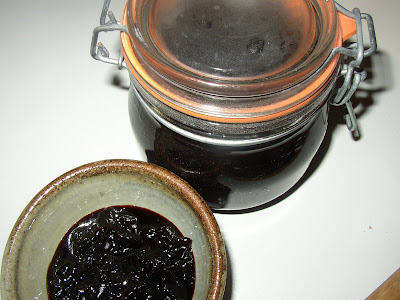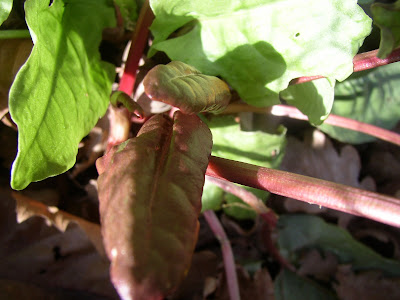In July 2004, we set off on our summer holidays, the car laden, as usual, with sports kit - tennis racquets, golf bags, fishing rods, walking gear, several changes of footwear each: everything that was needed for the usual active family holiday. We drove to Scotland, stopping on the way to visit friends, where we would be staying with several other families from our wider family in a huge 18th century mansion in Angus, before going to to visit good friends on the island of Mull.
We both really needed a holiday: Lucius had an issue at work which made his shoulders hunch up with tension whenever he talked about it. I was embroiled in an unpleasant spat with our village council, and the first of our four children was about to go to university which would mean change for the family (this was the first family holiday which didn't include everyone). The children were happy in the back of the car, surrounded by stuff, and plugged in to their music.
We were the last to arrive: everyone was on the terrace overlooking the River North Esk having drinks in the early evening sunshine. We joined them, had dinner, and then went to find our rooms, Lettice sharing with her cousin, the boys together in the room next to ours. There was chatter and laughter, it was good to be surrounded by family; there was the promise of a whole week of activity and exploration in this beautiful place in the foothills of the highlands. Plans were made for golf the next morning, and for a group of us to visit Glamis Castle nearby.
I remember that on the way to Glamis we talked about illness, we talked about how it would affect us, we talked about cancer, everyone's fear. But, looking back, we didn't really address it, we talked about it as something that would affect other people. Despite our increasing middle age, we still felt invincible, whatever evidence there was to the contrary, and however much we knew it wasn't so.
All that confidence was shattered within moments of returning to The Burn. Lucius was playing tennis with Horatio - no longer a gentle game of adult v child, but now, a game between two males who both wanted to win, one improving every day, the other wanting to carry on unbeaten as long as he could.
"Joanna, Joanna! Lucius has come in and he's lying on the sofa and he's not very well." As soon as I saw him, I could see that something was really wrong. He was grey. He looked weak, he looked wounded. I went to the office to see if we could telephone a doctor, but the surgery was closing, and it was difficult. James, my brother-in-law, and an orthopaedic consultant, took one look and said we should take him to the nearest A&E. So off we went.
Lucius's brother Chippy drove, in his brand-new car that was not yet properly run in. James sat in the front, telephoning the emergency services to find out where to go, and whether an ambulance could meet us. No. So he talked to the hospital direct. All this in a low voice in the front. Lucius was lying across the seats at the back, his head in my lap - clammy, silent, sick.
It was an hour's drive to Dundee. We had to drive through the city, one we didn't know, and with confusing signposts. All the time, James was talking to the hospital, taking a pulse every so often. Lucius groaned, James turned to examine him in the confined space, whispered to Chippy, and suddenly, the car, already going at speed, shot forward.
"Please be alive when we arrive at the hospital, please be alive when we arrive, please be alive when we arrive ..." I couldn't stroke him, he didn't want to be touched; I couldn't talk to him, he was turned in on himself. I bit my tongue - literally, to stop myself from crying - and repeated my mantra in my head: "please be alive when we arrive."
When we got there, he was bundled into a wheelchair and rushed in to the cardiac unit. I was directed to the front desk, where a smiling Scots lady asked for his name, and I burst into tears. "It's all right, lassie, it's all right," she soothed. It was the first of many small acts of kindness of strangers.
After an eternal little while, the doctor came to find us, to tell us what had happened, but, also, to get my permission to use heavy-duty drug treatment. He talked that medical language that the healthy never learn. "So, does that mean he's had a heart attack?" He looked surprised. He explained again, only this time I understood. A clot had come to rest in Lucius's heart, luckily for him in a place where damage tended to be less; luckily for him, he lay down more or less immediately; luckily for him, he was in the cardiac unit within a couple of hours.
We didn't see him until after he had taken the clot-buster. He was in a high-tech chair, wired up to the nines, still grey, still wounded, but smiling weakly, beginning to look out again. We went home after he was settled onto the high-dependency ward, where staff outnumber patients, and where patience and kindness are everyday virtues.
It was a bad moment, telling the children. It was worst for Horatio - he couldn't believe it was serious: "Mum, he just said he wanted to stop playing because he felt sick, and then he collected up all the balls." So H had wandered off to find another tennis partner, and never gave the matter another thought. It's not like the movies - it's not even how you imagined it would be.
He stayed in hospital a week, champing at the bit by the end, longing to get back to his life. But he wasn't allowed to go to Mull, for fear of another attack, and he wasn't allowed to drive for a month. Every day he got stronger, but not as quickly as he wanted to believe. Now you would never know. We were lucky. We were very lucky.
...
We were in shock. How could this happen to my virile, averagely fit, strong husband? We got answers from the British Heart Foundation. You know them, too: smoking, high blood pressure, high blood cholesterol, lack of activity, stress, heredity.
We needed to DO something. We both read the BHF booklets:
People who eat at least five portions of fruit and vegetables a day are less likely to have heart disease. We do not know exactly why, but it is thought to be due to the antioxidant vitamins they contain ... there is not yet enough evidence that taking vitamin tablets has the same effect.
Eating oily fish once or twice a week may help to reduce your level of triglycerides (fatty substances found in the blood), and prevent blood clots from forming in your coronary arteries. It can also help to improve your chances of survival after a heart attack. The particular oil in fish that has these beneficial effects is known as 'omega-3'. It is found mainly in oily fish such as herring, kippers, mackerel, pilchards, sardines, salmon, fresh tuna, trout and anchovies.
Well, wouldn't you give it a try? In practice, we were doing quite a bit of it anyway, but, as we looked carefully at the advice, we could see that changes were needed.
Five portions of fruit and veg a day is the most effective change you can make. If you only make one change, this should be it. Lots of people say they don't know how much there is in a portion. Well, it's one apple, or banana, or orange; it's two clementines, two Kiwi fruit. It's a slice of melon, a cup of berries. It's two or three tablespoons of fruit salad or stewed fruit. It's a small bowl of salad, a couple of serving spoons of veg. Just eat more, and keep on eating them!
Eat less fat overall, and cut right down on saturated fat. So butter, hard cheese, lard, suet - all obvious no-noes. Ghee, too, if you're keen on Indian food. But also coconut oil and palm oil - and these are used extensively in industrially processed food. So: read the labels. Welcome monounsaturates (olive oil, walnut oil, avocado), polyunsaturates (sunflower oil, soya oil, fish oils), omega-3 fats (oily fish, walnuts, soya).
Keep a healthy weight. I struggle with this. Although this way of eating helps, it is not a slimming diet in itself. Kalyn has inspired me to explore the South Beach Diet, and I'll post on how that goes. The BHF recommends checking by measuring your waist - anything over 32" is bad, over 35" very bad.
Cut down on salt. There's a strong connection between high consumption of salt and high blood pressure. There's a HUGE amount of salt in industrial food, although things are beginning to improve. Read the labels. Better still, make your own food; don't add salt, you'll get all you need from the processed food you do buy.
Watch out for hidden fats and salt. Here are the daily guidelines (men first, women second): fats 95g/70g (less than a third should be saturated); sugars 70g/50g; fibre 20g/16g; salt 6g/5g.
It's forever and it works. So don't beat yourself up when you backslide, and remember the 80/20 rule - if you get it right four-fifths of the time, that's fine. Enjoy. And then, please, share your recipes with the rest of us.
How The Heart of the Matter works: The first theme is going to be Finger Food, we thought that it would be perfect for the 'introduction party' of this event. The last day to send your entry is the 22 of March (this month, send it to i_beretta AT yahoo DOT it), please remember to link here and that we want only one-event entries.
























































